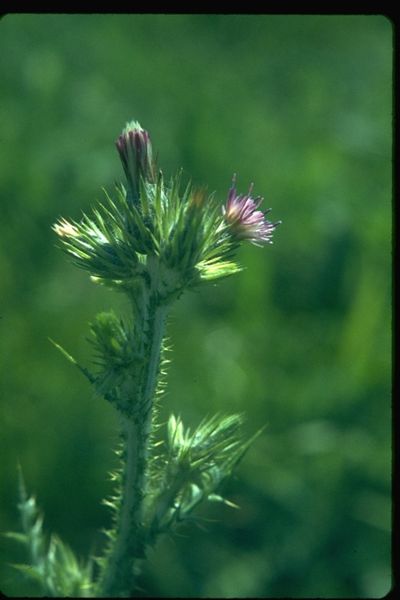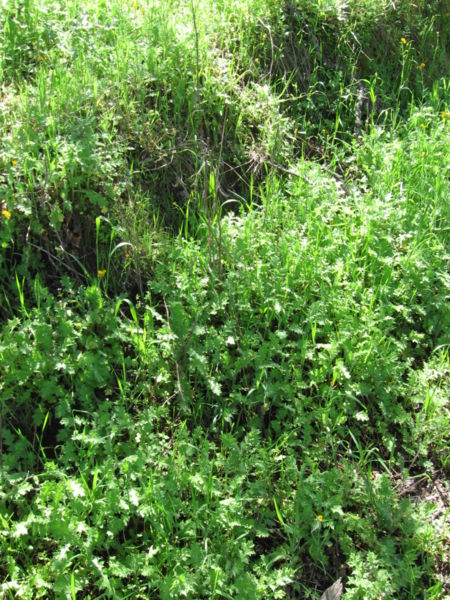Carduus pycnocephalusCarduus pycnocephalus (common names include Italian thistle, Italian plumeless thistle, slender thistle and Plymouth thistle) is a species of thistle native to the Mediterranean region of Europe and Asia which has become a noxious weed in Australia, New Zealand, South Africa, South America, and North America, especially in California, where it is a C-listed weed by the California Department of Agriculture and a Moderate rating by the California Invasive Plant Council [1]. It favors grasslands, woodlands, and chaparral vegetation types, but is especially prevalent in oak woodlands in and around the Central Valley. It is found in disturbed areas, often with basaltic soils, fertile soils, or soils with a relatively high pH (> 6.5) (Bossard et al. 2000). A winter annual, the plant stems range from 8 in to 6.6 feet (2-20 dm) and are glabrous to slightly wooly. Stems are winged with spines. Basal leaves are 4-6 in (10-15 cm) 4-10 lobed; cauline leaves are tomentose on the underside and contain spines on the lobe tips. Flower heads are 2-5 per cluster, densely matted with cobwebby hairs at the base of the phyllaries and spiny towards the tips. Corollas are pink to purple, approx. .4-.6 in (1-1.4 cm) long, and the fruits are brown to gold, with a bristly, minutely barbed pappus (Hickman 1993; Brossard et al. 2000). Italian thistle can grow densely, crowding out other vegetation with its rosettes in the winter, thereby preventing establishment of those plants. Its spiny leaves, stems, and phyllaries prevent animals from grazing on it and nearby forage (Parsons 1973). Its tendency to grow under the canopy of oaks increases the risk of fire damage to those trees, as fire can carry to the canopy easier. Mechanical methods can be effective but must be done before the plant sets seed. Additionally, the root must be severed at least four inches (1 dm) below the ground to prevent the plant from regenerating. Mowing and slashing are not reliable as the plant is able to regrow and produce seed even at a height of 3 inches (8 cm) (Tasmanina Dept. of Agriculture 1977; Brossard et al. 2000). Biological control agents have limited success with Italian thistle. Insects that tested host-specific by the California Dept. of Agriculture and caused significant damage to the reproductive structures of the plant have not been utilized due to concerns about possible predation of native thistles in California (Sheppard et al. 1991). Puccinia cardui-pycnocephali is a rust apparently exclusive to Italian thistle; other rust species have been found on the plant as well (Olivieri 1984; Bruckart 1991). Grazing by sheep or goats (not cattle) in Australia has showed promise as well (Bendall 1973). Chemical control can be achieved with a variety of products including: Clopyralid, glyphosate, Diquat, Picloram, and 2-4 D ester. However, caution must be exercised when using these products and they are not always appropriate, especially near water surfaces or other sensitive natural resources (Brossard et al. 2000). Check with state, county, or regional regulations concerning these products.
From Wikipedia, the free encyclopedia
|
|

